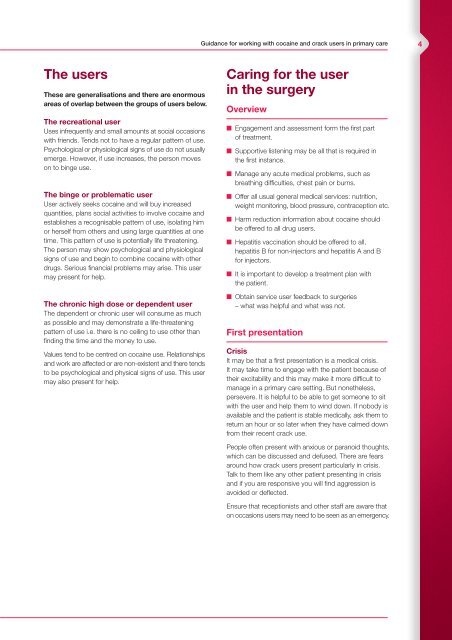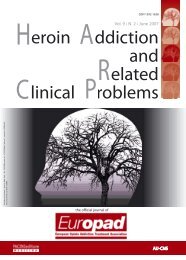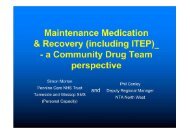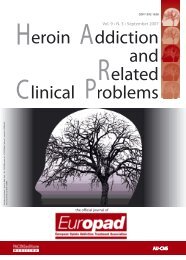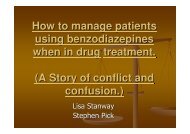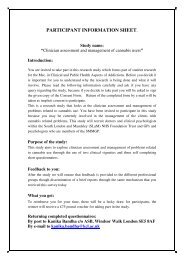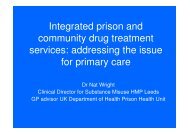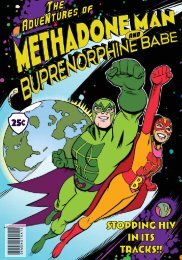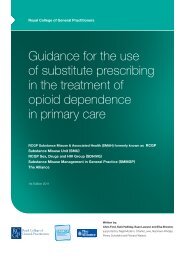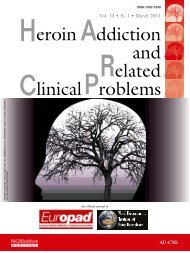cocaine guidance - Royal College of General Practitioners
cocaine guidance - Royal College of General Practitioners
cocaine guidance - Royal College of General Practitioners
- No tags were found...
Create successful ePaper yourself
Turn your PDF publications into a flip-book with our unique Google optimized e-Paper software.
Guidance for working with <strong>cocaine</strong> and crack users in primary care 4The usersThese are generalisations and there are enormousareas <strong>of</strong> overlap between the groups <strong>of</strong> users below.The recreational userUses infrequently and small amounts at social occasionswith friends. Tends not to have a regular pattern <strong>of</strong> use.Psychological or physiological signs <strong>of</strong> use do not usuallyemerge. However, if use increases, the person moveson to binge use.The binge or problematic userUser actively seeks <strong>cocaine</strong> and will buy increasedquantities, plans social activities to involve <strong>cocaine</strong> andestablishes a recognisable pattern <strong>of</strong> use, isolating himor herself from others and using large quantities at onetime. This pattern <strong>of</strong> use is potentially life threatening.The person may show psychological and physiologicalsigns <strong>of</strong> use and begin to combine <strong>cocaine</strong> with otherdrugs. Serious financial problems may arise. This usermay present for help.The chronic high dose or dependent userThe dependent or chronic user will consume as muchas possible and may demonstrate a life-threateningpattern <strong>of</strong> use i.e. there is no ceiling to use other thanfinding the time and the money to use.Values tend to be centred on <strong>cocaine</strong> use. Relationshipsand work are affected or are non-existent and there tendsto be psychological and physical signs <strong>of</strong> use. This usermay also present for help.Caring for the userin the surgeryOverview■ Engagement and assessment form the first part<strong>of</strong> treatment.■ Supportive listening may be all that is required inthe first instance.■ Manage any acute medical problems, such asbreathing difficulties, chest pain or burns.■ Offer all usual general medical services: nutrition,weight monitoring, blood pressure, contraception etc.■ Harm reduction information about <strong>cocaine</strong> shouldbe <strong>of</strong>fered to all drug users.■ Hepatitis vaccination should be <strong>of</strong>fered to all,hepatitis B for non-injectors and hepatitis A and Bfor injectors.■ It is important to develop a treatment plan withthe patient.■ Obtain service user feedback to surgeries– what was helpful and what was not.First presentationCrisisIt may be that a first presentation is a medical crisis.It may take time to engage with the patient because <strong>of</strong>their excitability and this may make it more difficult tomanage in a primary care setting. But nonetheless,persevere. It is helpful to be able to get someone to sitwith the user and help them to wind down. If nobody isavailable and the patient is stable medically, ask them toreturn an hour or so later when they have calmed downfrom their recent crack use.People <strong>of</strong>ten present with anxious or paranoid thoughts,which can be discussed and defused. There are fearsaround how crack users present particularly in crisis.Talk to them like any other patient presenting in crisisand if you are responsive you will find aggression isavoided or deflected.Ensure that receptionists and other staff are aware thaton occasions users may need to be seen as an emergency.


